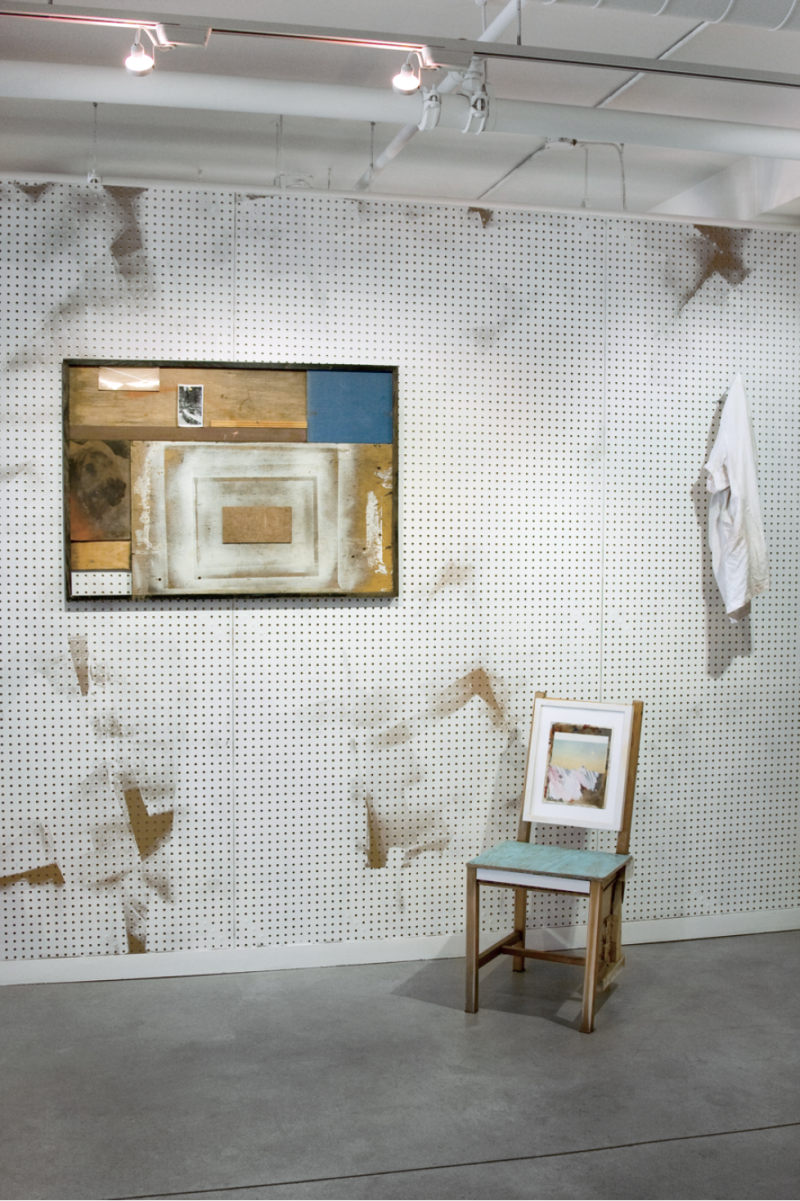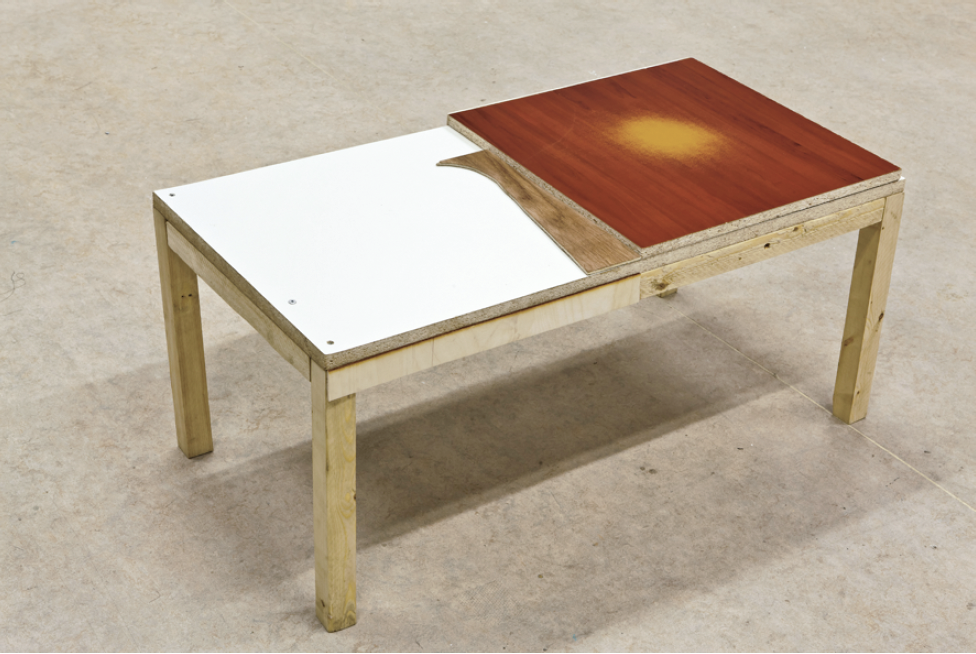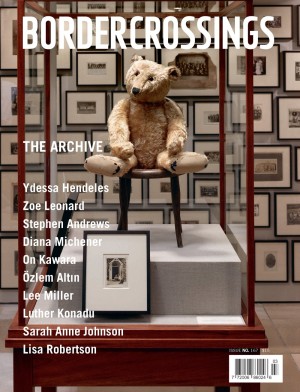Liam Crockard

Liam Crockard, (Standing on the bar, a stupid grin) “Friends,” he says. “I come from humble circumstance and rose up in the world by my own efforts. And if I’m to leave my footprints in the sands of time, let it be in a pair of workshoes.” 2011, perforated hardboard, collage, 84 x 196”. © Liam Crockard. Images courtesy O’Born Contemporary, Toronto.
Liam Crockard’s “Month of Sundays” at O’Born Contemporary is not his first solo show in Toronto. In fact, it is not even his first solo show this year (that would be “Domestics,” which was at the now-defunct 107 Shaw Gallery in April). Nevertheless, “Month of Sundays” has the feeling of a breakout debut for the young artist (Crockard graduated from OCAD in 2008), and it also signals a new direction for O’Born itself. This fast-rising commercial gallery has been around for three years and re-launched in September 2010 at its current location on the hip Ossington strip. Crockard is the first artist to show at O’Born who does not explicitly identify as a photographer—instead, his engagement with the photographic image manifests mainly through a collage practice that overlaps his sculpture and video work.
One of the first things the viewer might notice on walking into “Month of Sundays” is that Crockard has constructed an intervention into the gallery’s administrative space. The walls are lined with low wooden benches painted white, and the office exterior has been covered over by sheets of perforated hardboard, also haphazardly whitewashed, that serve as a prop for a wall sculpture and a white t-shirt hanging from a peg (in fact, the shirt that Crockard wore while painting the installation). A makeshift chair characteristic of Crockard’s recent furniture sculptures sits on the floor nearby. Constructed roughly out of scrap wood with a framed abstract collage serving as its back, the chair bears a thin application of blue and white paint that rhymes visually with the wall piece, a framed bricolage that recalls Rauschenberg’s combine paintings of the early ’60s. Altogether, this work makes up an installation with the long-winded title (Standing on the bar, a stupid grin) “Friends,” he says. “I come from humble circumstance and rose up in the world by my own efforts. And if I’m to leave my footprints in the sands of time, let it be in a pair of workshoes.” This apparent boast at first seems calculated to invoke a blue-collar, tool-shed ambiance and affirm the authenticity of Crockard’s honest, useful labour, but if the title strikes you as self-parodically hyperbolic, it is.
The short video piece projected on the gallery’s back wall offers a counterpoint and provides the context for discerning the artist’s attitude. In it we see Crockard idly kicking about a parking lot in his hometown of Kitchener, collecting stones that he arranges on the ground before chucking them at the giant steel drum of the water reservoir that looms in the background. This picture of the loiterer at play in the vacant landscape of industry provides the flipside to Crockard’s definition of artistic labour, which becomes even clearer when you learn the source of the aforementioned long title. It derives from a monologue delivered, while in the middle of a hallucination, by the titular protagonist of Cormac McCarthy’s 1979 novel Suttree. In actuality, the character is not a self-made paragon of humble hard work but a houseboat-dwelling vagrant who lives a picaresque life of petty schemes.
Accordingly, Crockard’s work is an ongoing process of experimentation in the territory between work and play, craft and art, idleness and effort. In this sense, the gallery does take on an aspect of a workshop during “Month of Sundays,” but in the form of a stage or film set in which Crockard performs gestures of collecting, arranging and constructing that mimic “real work” in humorously provisional, tentative forms.

Liam Crockard, All Thumbs, 2011, buffed formica and found wood.
In this show the collage process takes on a more abstract, materially driven character. One gallery wall is occupied by three sculptures that combine hardware-store materials (laminate flooring, wood, countertop swatches) with hardcover book jackets (the titles are obscured, but these clothbound covers formerly held pages that Crockard has since cut up for collage fodder). One, Awful Time in Jean-Drapeau, includes a blurry personal snapshot of dazed-looking youths lounging in a park. On the opposite wall, five equally sized small constructions use the same language of prosaic wood panelling, but arranged in orderly vertical bands, each with a single photographic image almost totally obscured by the surrounding layers of matter.
Another wall work, Gleener, resembles one of Tatlin’s corner reliefs in its crude, bristling agglomeration of various scrap wood blocks—an appropriately Constructivist reference given that all its parts were reclaimed from All Thumbs, Crockard’s recent series of benches. As with the seating that lines O’Born, however, Crockard’s furniture is less invested in facilitating sociability than in investigating the fetishistic transformation that turns objects of use into objets d’art.
This concern with the nature of work and the origin of value takes on extra resonance given that Crockard’s hometown of Kitchener, once a thriving hub for lumber, rubber, felt and leather, has largely de-industrialized in recent years. Month of Sundays, the piece that gives the show its title, is a blown-up print of a photograph taken by Crockard (originally presented in a photocopied zine) of a factory exterior in Kitchener in which a makeshift bench has been constructed from a board set atop overturned buckets. Crockard cites such forms of “jury-rigged construction and ‘making-do’” as an inspiration for his practice, but the decline of his hometown’s fortunes signals the larger shift that has seen stable industrial work in the Western world evaporate in favour of more precarious, self-directed forms of “immaterial” and cultural labour (for which contemporary artists are practically the test subjects). We are all making do with what we can these days. ❚
“Month of Sundays” was curated by Natalie MacNamara and Lili Huston-Herterich and exhibited at O’Born Contemporary in Toronto from August 13 to September 24, 2011.
Saelan Twerdy lives and writes in Toronto.

